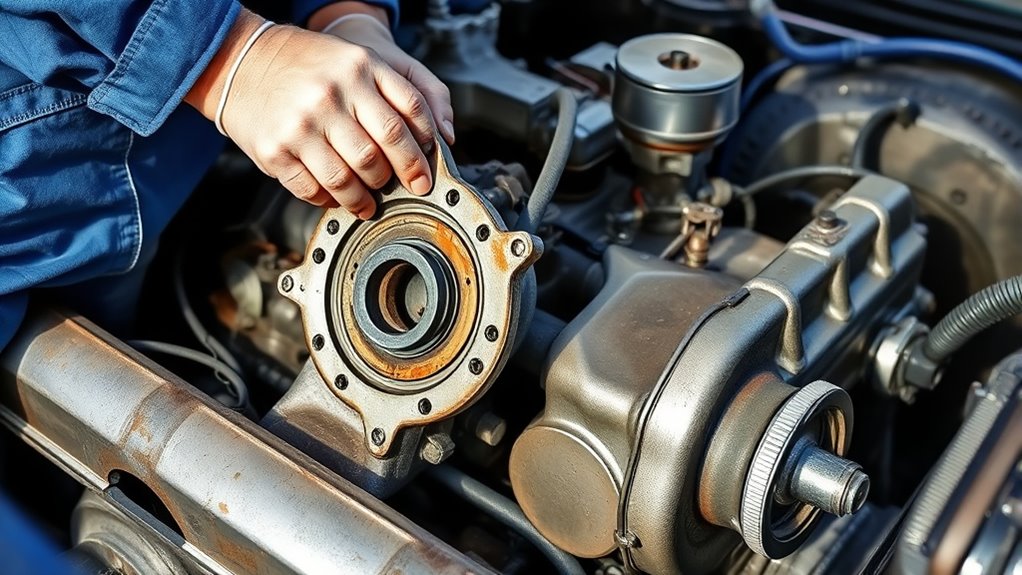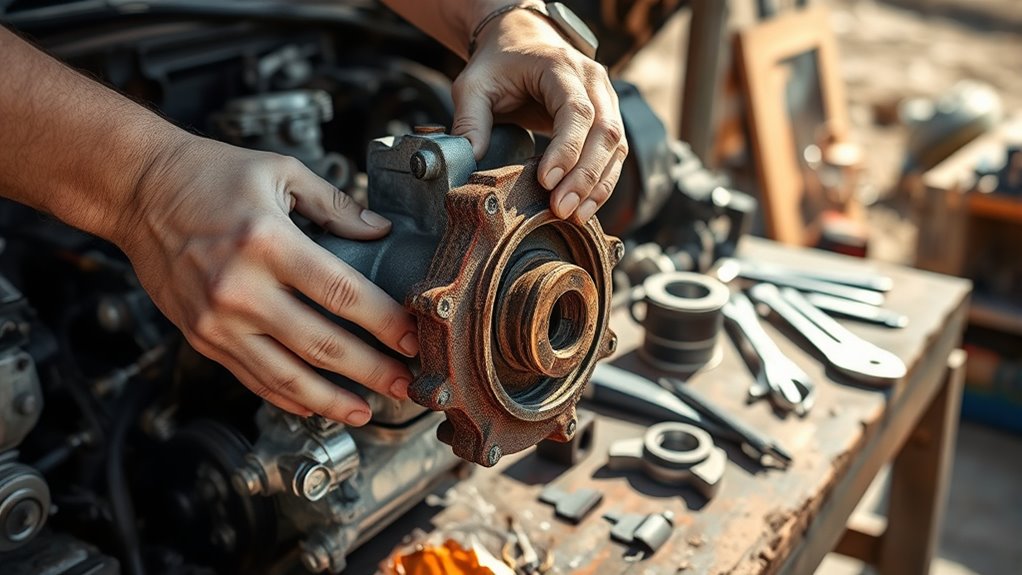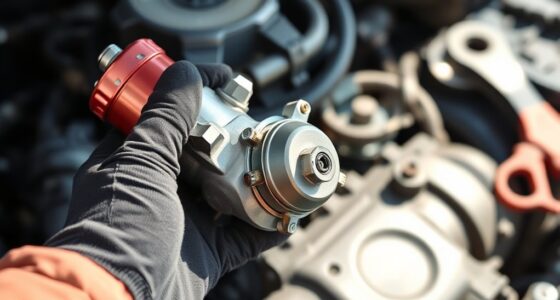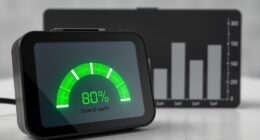If your engine is overheating, coolant leaks, or you hear squealing noises, it might be time to replace your water pump. The process involves inspecting for leaks, checking belt tension, and replacing worn belts or the pump itself to guarantee proper coolant flow. Correct belt tension is vital to prevent strain and failure. Staying on top of these issues helps avoid costly damage later. Keep going to learn what steps are involved in a successful water pump replacement.
Key Takeaways
- Signs of water pump issues include overheating, coolant leaks, and unusual noises.
- Causes of failure often involve worn seals, improper belt tension, or coolant leaks.
- Proper belt tension is crucial to prevent pump malfunction and ensure coolant flow.
- Regular inspection for leaks, residue, and belt condition helps maintain pump performance.
- Replacement involves installing a new pump, adjusting belt tension, and inspecting related components.

Are you experiencing overheating or coolant leaks? These signs often point to issues with your water pump, and addressing them promptly can save you from costly repairs down the line. One common cause is a coolant leak, which can develop if the water pump’s seals or gaskets wear out over time. When coolant escapes, your engine can’t maintain the proper temperature, leading to overheating. Another vital factor is belt tension. If the belt driving the water pump is too loose or too tight, it can cause the pump to malfunction or wear prematurely. Ensuring the belt has the correct tension is essential for smooth operation and longevity of your water pump.
Overheating and coolant leaks often indicate water pump issues and improper belt tension.
When inspecting your engine, look for signs of a coolant leak around the water pump area. Puddles of coolant beneath your vehicle, especially after it has been parked overnight, are a clear indicator. Also, check for a white or greenish residue around the pump or along the belt pathway, which suggests a slow leak. If the coolant level drops frequently without obvious cause, it’s likely your water pump is failing. Additionally, a squealing noise from the engine bay can indicate that the belt tension is off, causing inadequate contact with the water pump pulley. This can lead to inefficient operation and accelerated wear of the pump and belt.
Maintaining proper belt tension is vital because it directly impacts the water pump’s performance. If the belt is too slack, it can slip, causing the pump to spin irregularly or stop altogether. If it’s too tight, it places unnecessary strain on the pump’s bearings and the belt itself, leading to premature failure. You can usually check belt tension by pressing down on the belt with your finger—there should be a slight give, but not much. Many vehicles have an automatic tensioner that keeps the belt at the proper tension, but if it’s worn or broken, you’ll need to replace it to restore correct tension. Additionally, regular inspections of your Hyundai water pump can help identify early signs of failure before major issues develop.
Replacing your water pump involves more than just removing the old pump. You must also inspect and adjust the belt tension, ensuring it’s set to the manufacturer’s specifications. This step prevents future issues caused by a loose or overly tight belt. Proper tension also ensures the water pump operates efficiently, maintaining optimal coolant flow and engine temperature. Regularly inspecting the belt and checking for leaks can help you catch problems early, prolonging the life of your water pump and keeping your engine running smoothly. If you notice persistent issues despite these checks, it’s best to consult a mechanic to prevent further damage.
Frequently Asked Questions
How Long Does a Water Pump Replacement Typically Take?
A water pump replacement usually takes about 2 to 4 hours, depending on your vehicle’s make and model. During this process, you’ll need to remove the timing belt, so verify it’s properly inspected or replaced if necessary. Additionally, a coolant flush is recommended to prevent overheating and extend the life of your new pump. Your mechanic will coordinate these steps to minimize downtime and keep your engine running smoothly.
Can I Drive My Vehicle After the Water Pump Fails?
No, you shouldn’t drive your vehicle after the water pump fails. When it fails, the coolant mixture can’t circulate properly, causing the engine to overheat. Keep an eye on the temperature gauge; if it rises quickly, turn off the engine immediately. Driving with a failed water pump risks severe engine damage, so it’s best to have it towed and repaired before attempting to drive again.
What Are the Signs of a Water Pump Leak?
You’ll notice signs of a water pump leak like coolant leakage around the front of your vehicle or under it, which indicates a problem. You might also see steam from the radiator or smell coolant fumes. Additionally, if your engine overheats frequently, it’s a clear sign that the water pump isn’t circulating coolant properly. Catching these signs early helps prevent serious engine damage and costly repairs.
Is a New Water Pump Covered Under Warranty?
Yes, a new water pump is typically covered under warranty coverage. If it fails due to a manufacturing defect within the warranty period, the repair costs are usually covered by the manufacturer. However, keep in mind that warranty coverage may not include damage caused by improper installation or external issues. Always check your specific warranty details to understand what’s included and how to proceed if you need a replacement.
How Often Should I Replace My Vehicle’s Water Pump?
You should replace your vehicle’s water pump every 60,000 to 90,000 miles, but it’s wise to contemplate a coolant flush and thermostat replacement at the same time. Regular maintenance helps prevent overheating and engine damage. If you notice leaks, unusual noises, or temperature gauge fluctuations, it’s a sign to inspect your water pump sooner. Staying proactive ensures your cooling system remains efficient and your vehicle runs smoothly.
Conclusion
Replacing your water pump can save you up to 30% on repair costs compared to waiting. Remember, a functioning water pump is vital for your vehicle’s cooling system and overall performance. Regular maintenance can extend its lifespan and prevent costly breakdowns. Don’t ignore signs of failure—address them promptly. By staying proactive, you’ll keep your engine running smoothly and avoid the stress of unexpected breakdowns. Stay vigilant, and your vehicle will thank you for it.









